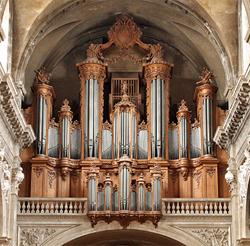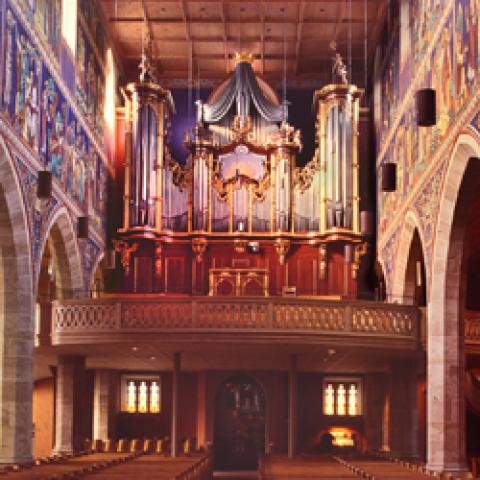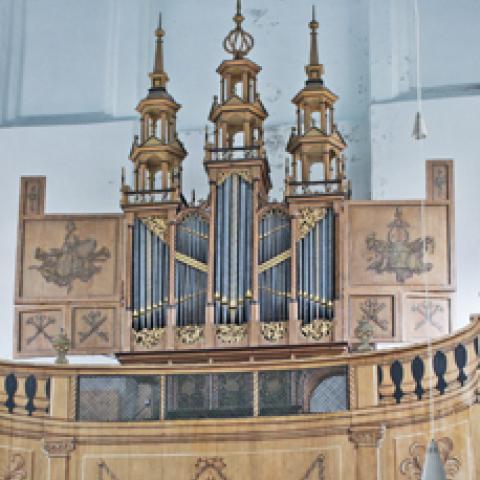Led by Marilyn Mason and Gale Kramer, the University of Michigan Historic Tour LVI began on the Mediterranean in sunny Barcelona, then traversed southern France to Bordeaux on the Atlantic coast via Toulouse and Carcassonne. From there we followed Conques, Poîtiers, Angers, Orléans, Chartres, the Chapelle Royale at Versailles, and finally Paris itself. Historic churches and cathedrals with organs in the Catalan, French classic, and French symphonic traditions graced our way, and frequently our host organists would improvise, lecture, and assist tour members at the console. Several visits to museums and historical sites as well as sampling the local cuisines along the way complemented much music making.
Barcelona
Barcelona, the capital of Catalonia, is a vibrant cosmopolitan port city with ancient roots, with fine museums and architecture spanning centuries. Catalan organ building flowered here in the 16th century, taking a different path from that in Castile and central Spain, where organ building reached its peak in the 17th century. Linked by trade and geography to continental Europe, Catalonian builders were influenced by the Flemish, North Germans, and French. The organs usually have several reeds, although in Catalonia reeds never became as numerous or prominent as in the rest of Spain. Trompetas and Baixons (Clarins) are powerful and bright, and the organs are rich in mutations, cornets, and mixtures (Pie, Simbalet). Often there are colorful solo reeds on secondary divisions. Catalan cases are flat, narrow, and usually tucked into a small space. Even on smaller instruments there is usually a horizontal Trompeta or two, which affords economy of wind and space. Frequently there is a smaller Cadireta or Chair Organ suspended behind the organist (sometimes behind and under the organ bench), with a small chorus, mutations, and reed (Regalia, Cromorne, sometimes Trompetas).
As in baroque France, the music determined the registration—for example: Nazardo combinations using Nazardos and Quincenas; Lleno; Flautado; Campana (bell: unisons and Cymbalet). Rossignol, tympani, and bird stops are common. Often Iberian organ registrations were incorporated into builders’ contracts. Stops were divided for maximum flexibility of solo/accompaniment registration. The Principal (Cara 8′) would usually be of wood. Unique to Catalonian and Majorcan organ building, manuals divide between b2–c3 (in Castilian organs, c3–c#3).
Santa Maria del Mar
On the first day, we walked through Barcelona’s medieval city to Santa Maria del Mar (St. Mary of the Sea), where we met Neal Cowley, parish organist and a historian of Spanish organs. This vast basilica, built by Catalonian merchants and traders in the 13th century, has a history of important organs, beginning with Bernat Pons in 1393, and later instruments of 1464 and 1691. Lost in the Spanish Civil War were the 1797 ‘large organ’ by Jean-Pierre and Dominique Cavaillé (Aristide’s father and grandfather built several large organs in Barcelona) and the ‘small organ’ (1495, 1672, for accompanying chant). The current organ, the ‘small organ’, is a 17th-century instrument by an unknown builder from the convent in Vic. There are two manuals, a large 14-stop Orgue Major (II), and a 6-stop Cadireta (I). Using casework and pipes found in an antique shop and rescuing bellows and keyboards from an old farmhouse near Vic, Gerhard Grenzing rebuilt this instrument following the tradition of the period and by studying the few remaining period instruments. Particularly notable is the powerful warmth of the Cara, the blossom of the flutes, and impressive ensemble, able to fill the large Gothic space. The parish plans for a new ‘large organ’ to replace the lost Cavaillé.
Recitals—Barcelona Cathedral
At the Barcelona Cathedral (completed in 1298), eleven of our tour prepared for a late afternoon concert of Spanish music on the 1538 Pere Flamech organ (IV/58), with its casework by Antoni Carbonel towering over the San Ivo door near the apse. One of four major organs by Flamech, it has been significantly modified over the years. The ‘Batalla’ organ (IV) of Trompeta Magna 16′, Trompeta Real and Clarins Clars 8′, Baixons and Clarins Alts 4′, and Violetes 2′ (all horizontal reeds) resonated through this vast space scented with candles and incense and alive with thousands of pilgrims and visitors.
Academia a l’Orgue Barroc
Later that week, tour members performed at the ‘Academia a l’Orgue Barroc’ at La Poble de Cérvoles, where our hosts were Maria Nacy, the Academia founder, with three of her enthusiastic young students. The Academia’s organ hangs on the mid-front right wall of the parish church. It is a stunning restoration by Wilfried Praet of a 2-manual/8′ Pedal 1752 Anton Cases organ, with a 3-stop Cadireta Interior added by Joseph Cases/Soler in 1784. Another very fine Praet reconstruction was at St. Jaume, Ulldemolins. This 2-manual instrument with full choruses, bright reeds, and lovely Cara featured painted case doors of the Annunciation by an anonymous female artist. An El Greco painting behind the altar and Catalan icons completed the space. The organ, brought to the church via an enthusiastic priest and funded by parish and town, is a source of regional pride. Back in Barcelona, Gerhard Grenzing welcomed us to his workshop, where we saw several works in progress. Grenzing’s repertoire of over 170 organs includes significant European restorations and new instruments (e.g., Brussels Cathedral IV/60).
Cathedral de Santa Maria, Castello d’ Empúries
On our last day in Catalonia we saw the great Gothic Cathedral de Santa Maria, Castello d’Empúries, originally with an 11th-century instrument by Pere Granyera. The 51-stop, 4-manual gallery instrument (Scherer circa 1600/Grenzing 2004) combines Spanish and classical French characteristics with an expanded 16′ Pedal and stops of Spanish and continental nomenclature (e.g., Alemanya IV on the Orgue Major, Oboe, but also Trompeta Batalla and Magna). This is one of the great organs of this region of Spain and France.
Following a visit to Salvador Dalî’s seaside home and his fantastical museum at Figueras, the rolling hills and meadows of France welcomed us to the Abbey of Sainte-Marie, Fontfroide. Following Cistercian tradition, this vast Romanesque abbey church never had an organ; the Offices and Mass were all chanted a cappella.
Basilica of SS. Nazarius and Celsus, Carcassonne
Many great (now former) monasteries and churches are along ancient pilgrim and trade routes. In the walled city of Carcassonne, the Basilica of SS. Nazarius and Celsus has a Romanesque nave around which, in 1269, a Gothic cathedral was built. Fourteenth-century stained glass illumines the 1522 organ case. The instrument combines a 1679 organ by Jean de Joyeuse (III/24), with renovations and an 8-stop Récit added by Jean-Pierre Cavaillé in 1775 (III/32). Fomentelli integrated the two instruments in 1985 (IV/40). Here is an example of the late French classic style, with cornets on every manual, Grand Cornet, and powerful bombardes. Unique to the Carcassonne organ are two Positif divisions (Positif Intérieur and Positif de dos), in addition to the Récit and 28-note Pédale. The upraised faces of tourists and pilgrims toward the loft attested to this captivating instrument as Marilyn Mason gave an impromptu lesson on de Grigny.
A visit to L’église Sainte Marie de Cintegabelle brought us to Moucherel’s splendid 1741 instrument, restored in 1989 by Boisseau & Cattiaux, with its sparkling Plein Jeu, voluptuous Grands Jeux, and stunning wide and shallow case topped by golden angel musicians.
Toulouse, Languedoc, Dordogne
In Toulouse, organist Jean-Claude Guidarini led us to Saint-Pierre des Chartreux, where high over the former Dominican choir area in the large apse presides the 1683 Delauney (IV/51) instrument, restored by Joseph Cavaillé-JB Micot in 1783, and Grenzing 1983. Several hours later we walked to Saint-Sernin and the towering Cavaillé-Coll organ of 1889, with pipework from Daublaine-Callinet (1845). Following Guidarini’s brilliant improvisation, our group enjoyed hours of playing in the empty basilica.
At Albi in Languedoc, Mary Prat-Molinier met us high in the loft at the red brick fortress of the Cathédrale Sainte-Cécile, built at the end of the Albigensian crusade (13th century). Built in 1735 by Christophe Moucherel as a 43-stop organ, Lépine added a Bombarde manual in 1747, and Formentelli restored it in the mid 1970s, incorporating many remaining pipes. Each division has a Cornet séparé, and the Voix humaine is new, after that of Cintegabelle. Next door we enjoyed the Toulouse-Lautrec museum in the former bishop’s palace.
At Sarlat-la-Canéda in the Dordogne valley, near a lively public market in this medieval city, Henry Jullien, a former pupil of Susan Landale, improvised and shared console time on a unique 37-stop Jean-François Lépine organ of 1750, restored by Cattiaux in 2005, in the Cathedral of Saint-Sacerdos. From a family of builders, Lépine (who built for Saint-Roch in Paris) was a pupil of Dom Bedos, who inspected this instrument. The organ is 80% original, with drawings and clues in the gallery floorboard greatly aiding in the reconstruction of the action, chest layout, and winding system.
Bordeaux
The next day at Sainte-Croix Abbey in Bordeaux, we heard Daniel Tappe (a graduate of Oberlin, now at the Musik Hochschule at Hanover) in a recital of Clérambault, Froberger, Bach, and Kerll on Dom Bedos de Celles’ masterpiece. The 18th-century verdigris case with golden filigree and 16′ Montre glistened as the room filled with the sound of brilliant, powerful trompettes and cornets, full flutes, and the gravitas of the 32′ Bourdon and Grand Plein-jeu XIII of the Grand Orgue. One of the hallmarks of every great organ that we saw were the foundation stops, which, given the materials and acoustics of the churches, provided a richness and warmth supporting the tonal edifice. In the restoration, Pascal Quoirin of Carpentras followed Bedos’ 1766–78 L’Art du Facteur d’Orgues and used early inventories of the instrument as well as extant pipes, including the battered façade. With a full complement of couplers, reeds on all manuals, manual bombardes, and the ability to create terraced dynamics, the organ is capable of a more diverse repertoire and is clearly along the road toward the new symphonic style.
Poitiers
Following the Loire valley, we arrived at the Cathédrale Saint-Pierre in Poitiers. A lack of money prevented Aristide Cavaillé-Coll’s planned rebuild of François-Henri Clicquot and son Claude-François’ masterpiece, a 16′ ‘Grand Orgue’ of four manuals, 44 stops, and 28-note Pedale, with its original temperament including four perfect thirds. Organist Jean-Baptiste Robin pointed out that while of classical disposition, the organ carries the power and presence of later organs and is capable of a more diverse repertoire. Later in the week at St. Godard in Rouen, titular organist Nicholas Pien conversely spoke of their 1885 Cavaillé-Coll (III/38) and its ability to perform Vierne as well as French Baroque pieces. Widor, who dedicated the St. Godard organ, called it ‘Raphael’ to distinguish it from the Cavaillé-Coll in St. Ouen, which he called ‘Michelangelo’. With its piquant Swell Gambe and powerful intense reeds, it has an immediate presence in this smaller Gothic structure with wooden floor and ceiling. A Cavaillé-Coll choir organ (II/16) graces the apse.
Loire Valley
In the Loire Valley, we toured Fontevrault Abbey, a former monastic community of men and women under an abbess (later a prison where the author Jean Genet spent time), and the burial place of Eleanor of Aquitaine. That afternoon, following the Loire River, we came to the Cathédrale Saint-Maurice in Anjou province. The carved neo-Gothic staircase to the gallery matched the spired towers of the 1879 Cavaillé-Coll, containing earlier pipework, including a 1742 Positif. Restoration after World War II included electrification and additional stops.
Chapelle Royale at Versailles
Our gateway to Paris was the gilt and marble Chapelle Royale at Versailles, with its IV/37 instrument in the musicians’ gallery over the high altar. François Couperin premiered the Etienne Enocq/Robert Clicquot organ in 1711, and Gonzalez rebuilt it in 1936 (Widor wanted to keep the earlier 1873 Cavaillé-Coll rebuild). Recently, Boisseau et Cattiaux scrupulously restored the 1710 organ, keeping the 1736 (Louis-Alexandre Clicquot) and 1762 (Francois-Henri Clicquot) additions. Its console has features of the Poitiers organ, and it is also a 16′ instrument.
Paris, La Madeleine
We arrived in Paris to play the 1847 Cavaillé-Coll organ at the church of La Madeleine (IV/46). Here is Cavaillé-Coll’s first Voix Céleste and first reverse console (now electrified). Planned-for 8′ and 4′ Trompettes-en-Chamade have been added. Organiste-Titulaire François-Henri Houbart improvised à la Dupré, starting from the wide breadth of the Flûte Harmonique and colorful solo stops through waves of mixtures and reeds to full organ and powerful choruses anchored by the Bombarde. It was a thrill to play the Tournemire Te Deum in this grand space on this venerable instrument.
Saint-Gervais
Our last few days in Paris saw visits to still more instruments. The final Sunday of the tour found some of our group in the loft with Jean-Paul Leguay at Notre-Dame Cathedral, some at Saint-Eustache, and others at Mass at Saint-Sulpice with the sublime improvisations and service playing of Daniel Roth. That afternoon at Saint-Gervais where eight generations of Couperins worked, Elise Frist, an assistant organist, ably demonstrated the organ (V/41, 1628 Thierry, 1768 FH Clicquot, 1843 LP Dallery, 1974 Gonzalez, 2003 Muhlrisen). Indeed, the Couperins’ music fitted the organ well, with its balanced ensembles and clarity of voicing evoking that of Lépine, Delauney or Clicquot. Much original pipework remains, and the console has the oldest keyboards in Paris. The original pedalboard is mounted on the rear case, which is also embellished with etchings and photos of the many organists who have played and worked there.
Sainte-Marguerite and
Notre-Dame de Chartres
Sunday evening found us again in recital, this time featuring music of Widor, Tournemire, Dupré, and improvisations at the church of Sainte-Marguerite, built in 1624, and where the young Dauphin Louis XVII is buried. The organ is an 1878 installation by Stoltz Frères of Alsace.
A side trip to Notre-Dame de Chartres found us in the gallery with headphones on to be able to properly hear the instrument (IV/68, Relevage Jean-Marc Cicchero 1996). Without them we were surrounded by sounds of the Pédalier.
L’Église Saint-Antoine des Quinze Vingts
At l’Église Saint-Antoine des Quinze Vingts we found a unique 1894, 48-stop Cavaillé-Coll originally built for the Baron de l’Espée, who wished to play Wagner in his personal hotel on the Champs-Élysées. A purely symphonic instrument, it was moved to the church and enlarged in 1907.
Notre-Dame d’Auteuil and
Sainte-Clothilde
The Grand-Orgue of Notre-Dame d’Auteuil (Cavaillé-Coll 1884, Gloton-Debierre 1937–38) is a shining example of Cavaillé-Coll’s mature work. Dedicated by Widor in 1884, its sound evoked that of Saint-Sulpice. It is one of the most glorious instruments this organist has ever experienced. The 1938 renovation, under the auspices of a committee with Tournemire, Vierne, Duruflé, and Dupré, preserved the entire organ (III/52), enlarged and enclosed the Positif, and added pedal and manual mixtures. Josef Franck, the brother of César, was organist here, and in 1884 Widor and Dellier played the dedication. Its full flutes, generous fonds, and bombardes of great gravitas are well balanced and perfectly blended in the room. This was a favorite organ of the Duruflés and much of Paris; Marie-Madeleine Duruflé attended Mass here in her later years. Titular organist Frédéric Blanc told us that the original instrument intended for the church was loaned to the French government, whereupon Cavaillé-Coll enlarged it and installed it in the Trocadéro, which opened in 1878. At Sainte-Clothilde, assistant organist Olivier Penin improvised on the 1859 Cavaillé-Coll, renovated by Dargassies in 2004. It was a thrill to also play the instrument of Langlais, Pierné, Franck and Tournemire.
La Trinité
The La Trinité organ was built by Cavaillé-Coll in 1869 and reconstructed after the Paris Commune in 1871. Merklin rebuilt it in 1901, and in 1934 Pleyel-Cavaillé added combination action, batteries of reeds and mutations, and mixtures. It was again rebuilt in 1965 by Beuchet-Debierre, with further alterations and additions in 1984 and 1992. Messiaen referred to the remaining older pipework as the most admirable sounds on the instrument and considered the instrument a masterpiece.
Saint-Étienne-du-Mont and
Saint-Roch
Our final afternoon found us at Saint-Étienne-du-Mont, with organist titulaire Vincent Warnier improvising in the style of Duruflé, after which we spent several hours at the console. In 1930 when Maurice Duruflé was appointed here, the ailing 1873 Cavaillé-Coll (a rebuild of a 17th-century organ with original case) was renovated in consultation with Tournemire and Dupré. Work resumed after World War II (Marilyn Mason recalled her lessons on the front choir organ shortly after the war). Now electrified and enlarged, the main organ has been transformed and still possesses many pipes from all of its incarnations. Its brightness and color complement the wonderful late flamboyant Gothic sunlit nave of the church and indeed the music of Maurice Duruflé.
The last church we visited was Église Saint-Roch and its III/54 Cavaillé-Coll (1840, 1862), restored by Renaud in 1992, including the mechanical action with Barker levers on the Grand Orgue. At Saint-Roch, Cavaillé-Coll used pipework from previous organs dating to 1751. That evening, the group celebrated our final dinner near Sacré-Coeur Basilica on Montmartre.
Historic Organ Tour LVI showed us many treasures of the organ world from Catalonia and France. These instruments and the music written for them become vibrantly alive when yet again the organist places hands on those historic keys. From the camaraderie of our tour group to the magnificent organs of the Catalonian Renaissance and French classical and symphonic traditions, to the food and wine enjoyed on terraces in the warm evenings, our venture was a fun and enlightening two weeks.�
Tour members
Betsy Cavnar
Jeffrey Chase
Christine Chun
Joanne Vollendorf Clark
John Clark
Ronald DeBlaey
Richard Ditewig
Bela Feher
Janice Feher
Esther Goh
Steven Hoffman
Timothy Huth
Jerry Jelsema
Gale Kramer
Evelyn Lim
Rose Lim
Marilyn Mason
Enid Merritt
Paul Merritt
Mary Morse
Winnifred Pierce
Jean Savage
John Savage
Almar Otjes (tour guide)





